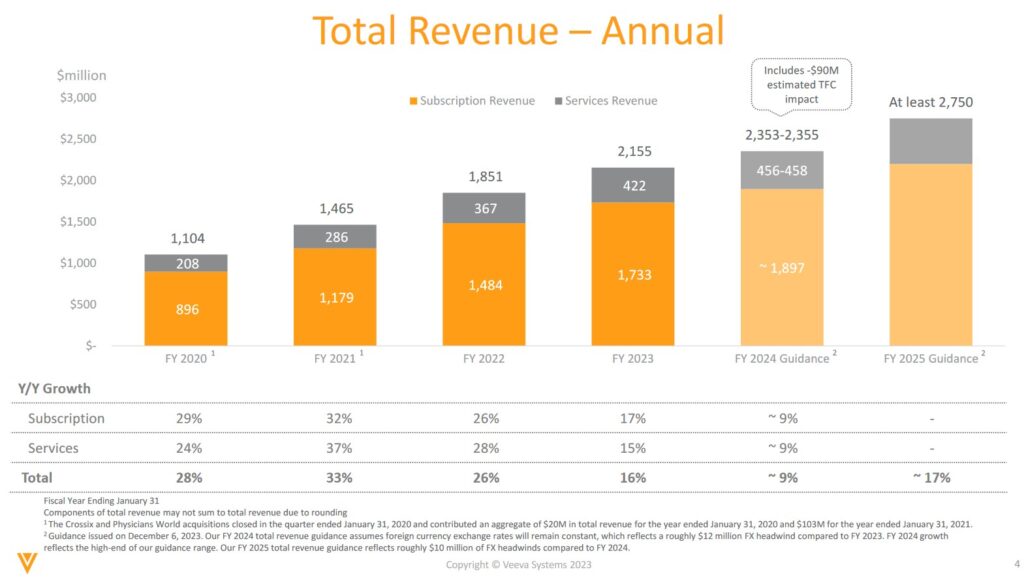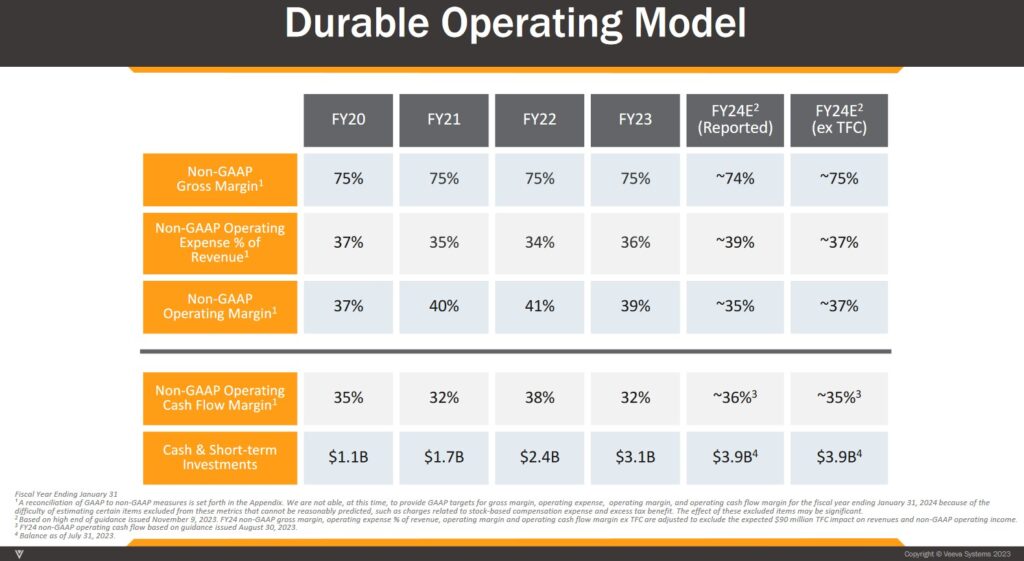Contents

In my August 23 Zoom Video Communications (ZM) post, I disclosed my rationale for initiating a position in this company. Part of my analysis included a review of ZM's proxy. On Page 16, I noted that one of the continuing Directors (Peter Gassner) is the CEO and a member of the board of directors of Veeva Systems Inc. (VEEV), a cloud computing company.
I was not familiar VEEV and decided to familiarize myself with it.
I present some of my findings below.
NOTE: VEEV has Class A and Class B shares. The Class A shares are the publicly listed shares. The Class B common stock has ten votes per share and the Class A common stock has one vote per share. As of January 31, 2023 (FYE2023), the founder and CEO, held ~44.9% of the voting power of VEEV's outstanding capital stock. The Class B common stockholders control 50.3% of the voting power of the total outstanding capital stock.
Business Overview
VEEV operates as a Public Benefit Corporation. This is a relatively new way of running a for-profit company that is legally obligated to consider the impact of its decisions on society and not just shareholders. This is increasingly important in a world where values such as a clean environment, equality, and education are being highly prioritized.
A company needs to be profitable in order to keep producing and adding value to employees, customers, and shareholders. This does not mean, however, that being profitable should be VEEV's primary priority.
When a company thinks beyond profit and:
- cares deeply about its employees;
- provides a great user experience;
- limits its negative impact on the environment; and
- encourages education and equality
employees are more likely to work in the company for the missions as opposed to just working for the company.
VEEV is the leading provider of industry cloud solutions for the global life sciences industry. Its:
- offerings span cloud software, data, and business consulting and are designed to meet the unique customer needs and their most strategic business functions from research and development (R&D) to commercialization;
- solutions help life sciences companies develop and bring products to market faster and more efficiently, market and sell more effectively, and maintain compliance with government regulations; and
- suite of products address the operating challenges and regulatory requirements companies in the global life sciences industry face.
By creating platforms that are purely designed to serve one industry, this vertical focus has allowed VEEV to shape its products for its specific customers to fit their specific needs.
Life Sciences is a large, critical, and growing industry that helps improve health care around the world. Currently, the industry is ~$2T+ in revenue and is growing ~6%/year.
VEEV's opportunity in life sciences is ~$20B. Its total addressable market (TAM) is from industry specific software and data with more than 50% of this coming from existing and recently announced products. The remainder is from areas of opportunity.
The TAM also includes high value professional services that currently make up ~20% of VEEV's revenue. This is not expected to materially increase or decrease over the coming years as VEEV does not want to get into low value or commodity services in any material way. The rationale behind VEEV's TAM is to provide industry specific software and data that is critical to life sciences.
VEEV's industry cloud solutions for the life sciences industry are grouped into two major product families - Veeva Development Cloud and Veeva Commercial Cloud. Both are designed to address pharmaceutical, biotechnology, and medical devices and diagnostics (MedTech) companies’ most pressing strategic needs in their commercial and R&D operations.
For financial reporting purposes, revenues associated with Veeva Development Cloud, Veeva RegulatoryOne, and Veeva QualityOne solutions are classified as 'R&D Solutions' revenues. Revenues associated with Veeva Commercial Cloud and Veeva Claims solutions are classified as 'Commercial Solutions' revenues.
R&D Solutions
These solutions horizontally integrate data and content through Veeva Vault, a content management system built on VEEV's own platform. It is the industry’s first tool that offers all applications in a unified and integrated server. It is a suite of applications that aims to help across 5 specific functions (commercial, clinical, regulatory, quality and manufacturing, and safety) within any company that is developing drugs or suppliers to those who are developing drugs.
Commercial Solutions
This entails vertically integrated customer relationship management (CRM) services and endmarket data and analytics solutions. VEEV CRM is a cloud-based customer relationship management platform used by pharmaceutical and biotech companies with commercial needs.
This CRM was originally built on the Salesforce 1 platform. In late 2022, however, VEEV announced that it will migrate the product to its own Vault platform. Although migration will begin in 2024, its existing users will have the option to continue to use CRM on Salesforce’s platform until 2030.
Customer Base
VEEV operates in 3 main industry segments - BioPharma, Medtech, and Consumer Products. VEEV currently generates ~94%, ~4%, and ~2% of its revenue from these industry cloud segments.
It has over a thousand customers consisting of large global pharma companies as well as pre-clinical biotechs.
The Medtech and Consumer Products segments represent smaller portions of overall revenue but each amount to a significant opportunity.
Within the BioPharma segment, 2/3 of VEEV's revenue comes from enterprise customers; these are VEEV's top 50 customers.
Small- to Mid-Sized Pharmaceutical companies, VEEV's second largest cohort, contributes 25% of revenue across ~700 customers. This group includes companies with multiple billions of dollars in revenue all the way to specialized biotechs that are commercializing for the first time.
Emerging biotech customers represent ~4% of VEEV's total biopharma revenue across ~300 customers. These are companies with less than a thousand employees and no approved commercial product.
Contract Research Organizations (CROs) represent ~5% of VEEV's revenue.
NOTE: While VEEV has a large numbers of customers, the top 10 customers accounted for 29%, 31%, and 36% of total revenues in the fiscal years ended January 31, 2023, 2022, and 2021, respectively. It relies on 'reference selling' meaning it uses reputation and recommendations from key customers in order to promote its solutions to potential customers. The loss of any key customers, or a failure of one or more of them to renew or expand user subscriptions for some or all products, could have a significant impact on VEEV's revenues growth rate, its reputation, and its ability to obtain new customers.
Some of the companies upon which VEEV relies for 'reference selling' are here.
VEEV generates strong operating income and margins to support future growth investments.
VEEV's FY2021 - FY2023 margins benefited from reduced travel and event spend due to COVID.
Part 1 Item 1 in the FY2023 Form 10-K has a comprehensive overview of the company.
The company's fiscal year end is January 31. Investors can expect the Q4 and FY2024 financial results at the beginning of March 2024.
Competition
Having established itself as the global standard for life sciences, VEEV faces little competition. By focusing specifically on the life sciences industry, it is extremely difficult for a generic CRM provider to compete.
This is borne out by ~80% of the global pharmaceutical sales representatives using Veeva CRM in 2022 versus ~33% in 2013.
The cost of switching to a competing software solution is high and carries substantial operating risks once users are fully acclimated to Veeva's CRM and the system is fully integrated into a company's operating activities. If a company were to switch to a competing software solution, there is substantial risk in:
- data loss during migration;
- disruption to sales activities, and/or
- the delay of product launches.
Companies within the life sciences industry are keenly aware of these risks. Time to market is more important than other industries because it is very time-intensive to develop drugs and patent duration is limited.
VEEV's clients are also less likely to switch to a competitor's products as more add-ons are purchased. In addition to VEEV's CRM product, it offers many complementary applications to existing customers. The average add-on penetration rate is currently above ~55% versus less than 10% in 2015!
Technology Infrastructure and Operations
VEEV's products are hosted in data centers located in the United States, the United Kingdom, the European Union, Japan, and South Korea. Any products used only within China are hosted in data centers located in China.
VEEV currently uses third parties to provide its computing infrastructure and manage the infrastructure on which its solutions operate. For example, for Veeva CRM and certain multichannel CRM applications, use the hosting infrastructure provided by Salesforce, Inc.. For Veeva Vault applications and certain other Veeva Commercial Cloud applications, VEEV uses Amazon Web Services.
At VEEV's November 3, 2022 Investor Day, VEEV revealed that ~60% of its subscription revenue is hosted on the VEEV Vault platform. Roughly 30% is hosted on the Salesforce platform and the remaining ~10% is hosted on other platforms.
As noted earlier, VEEV announced in late 2022 of its decision to migrate the services currently hosted by Salesforce to its internal platform. In preparation for this strategic initiative, VEEV has invested ~$2.2B in Research and Development during the FY2018 - Q3 2024 timeframe in preparation for its reduced reliance on third parties.
Process Changes Announced at 2022 Investor Day
On November 3, 2022, VEEV announced process changes in the areas of multi-year ramping deals and inflation.
Termination For Convenience Standardization
VEEV has historically endeavored to be consistent as it relates to customer contracts. In the past, most customer contracts had a one year term, so the notion of termination rights was not of significant importance.
With the creation of an operating system for drug development, multi-year deals with ramping subscription fees are becoming more common.
Historically, VEEV had a variety of different termination rights for ramp deals across customers. This resulted in inconsistency in the contracting process and variability in revenue recognition.
VEEV has now standardized Termination for Convenience (TFC) for customers with multi-year ramping deals. This allows a customer to terminate a master subscription agreement with VEEV without cause within a predefined notice period. This change simplifies contract negotiations and provides consistency for VEEV's customers.
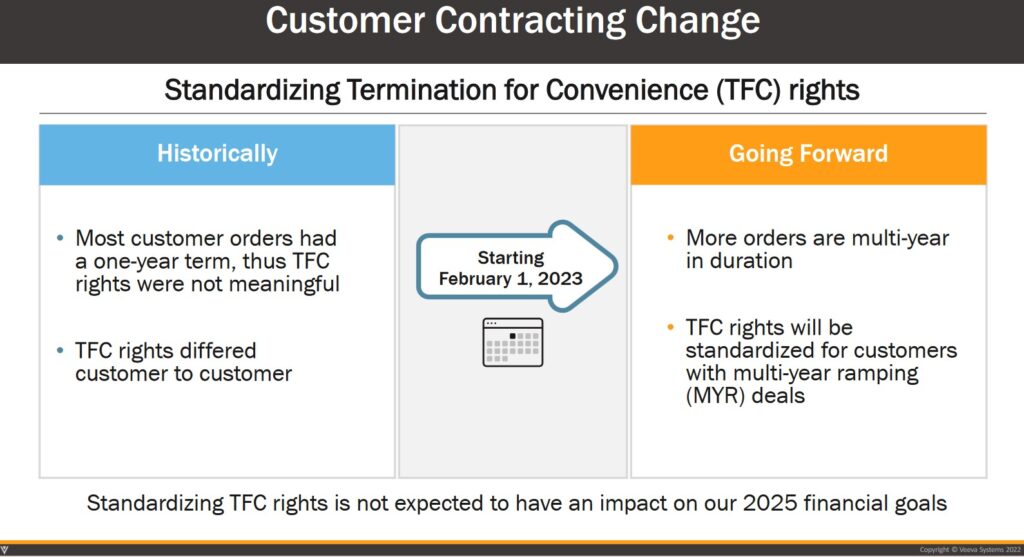
Source: VEEV - 2022 Investor Day Presentation - November 3, 2022
The following example of how contracting terms impact revenue recognition over the term of a multi-year ramping deal is provided below.
in this example: we have a three year deal with a billion ramp of two million in year, one four million in year, two and six million in year, three, as you can see for ramp deals with T. Per C. The subscription revenue ramps over time in line with our Billings rather than radically over the life of the contract.
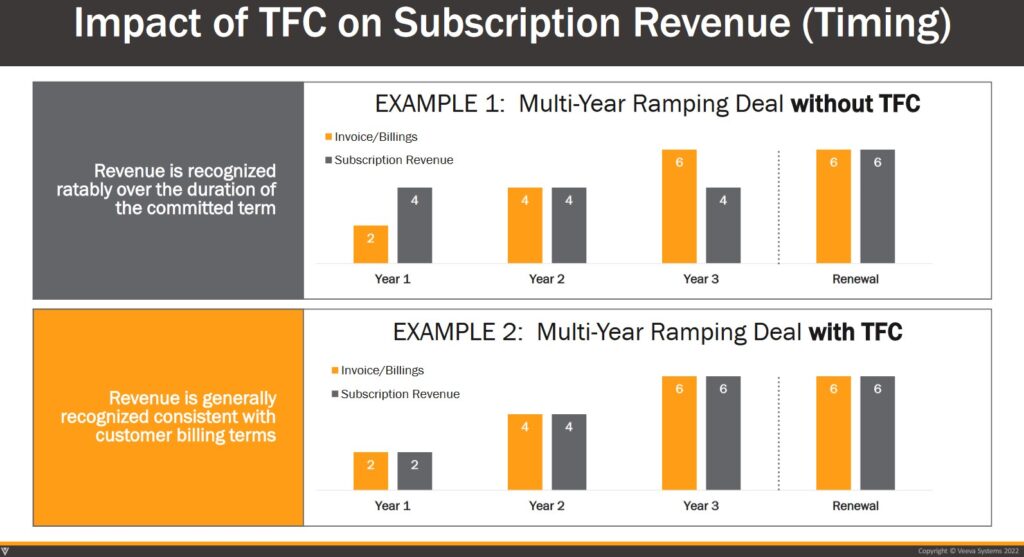
Source: VEEV - 2022 Investor Day Presentation - November 3, 2022
The key takeaway from this change with continued execution, is no impact to cash flows, billings, and total revenue on multi-year deals.
Inflation Adjustment
VEEV was founded in 2007 and has never raised the price of subscription products for its customers at renewal. Now that current inflation is higher than in recent years and could remain high in the coming years, VEEV introduced a new annual process to incorporate an inflation adjustment for new and renewal order forms. The annual increase will be the lesser of Consumer Price Index (CPI) or 4%; the first increases started in April 2023.
The impact to FY2024 revenue will be minimal. It will take a few years to roll out across VEEV's customer base due to the:
- timing of the inflation adjustment;
- the timing of customer renewals; and
- the contracting terms of specific customers.
CEO and NEO Compensation
As retail investors, we may have some concerns about a company’s CEO and Named Executive Officers (NEO) compensation. We, however, typically have insufficient share ownership to influence their compensation structure. It is, therefore, important that we determine if the CEO and NEO compensation structure aligns with our long-term shareholder interests. If the long-term incentive component makes up a large percentage of the CEO’s and NEOs’ compensation structures, I envision they will make decisions that align with my interests.
I look at a company’s Proxy Statement to determine the degree to which ‘pay for performance’ impacts executive compensation; the section on Executive Compensation in VEEV’s 2023 Proxy Statement is extensive.
In order to drive business results and maximize shareholder value, VEEV’s executive compensation is highly incentive-based and weighted toward long-term awards to emphasize long-term performance and support retention. The executive compensation program includes the use of stock-based compensation consisting of Performance-based Restricted Stock Units (PSUs), Stock
Options, and Time-Vesting Restricted Stock Units (RSUs); this applies not only to the CEO but also to the NEOs.
In reviewing the 'OUR PAY' section that commences on page 52 of 99, I am satisfied that VEEV's CEO and NEOs have 'skin in the game'.
Financial Review
Q3 and YTD2024 Results (VEEV has a January 31 FYE)
Refer to VEEV's Q3 2024 Earnings Release, Earnings Presentation, and Form 10-Q.
Management has stated on its Q3 earnings call that the current difficult macroeconomic environment is a headwind in its services segment. This is attributed to:
- limited funding in the biotechology space;
- cost-cutting measures across major pharmaceutical firms; and
- dynamic geopolitical issues.
These are likely temporary headwinds but how long they will persist is an unknown.
VEEV, however, continues to gain marketshare and is winning new customers in Veeva Vault and Vault commercial solutions.
Operating Cash Flow (OCF) and Free Cash Flow (FCF)
VEEV has impressive OCF and FCF growth track records.
In FY2015 - FY2023, VEEV generated OCF of (in millions of $): ~42, ~68, ~80, ~144, ~233, ~311, ~437, ~551, and ~764. In the first 3 quarters of FY2024 it generated ~854.
Annual capital expenditures are typically well under $20 million meaning FCF is almost the same as OCF.
While VEEV spends very little on CAPEX, it invests heavily in research and development. In FY2021 - FY2023, it invested (in millions of $): ~294, ~382, and ~520. In the first 3 quarters of FY2024 it invested ~465.
FY2024 Guidance
VEEV is currently tracking ahead of its 2025 targets.
The following reflects guidance provided at the November Investor Day.
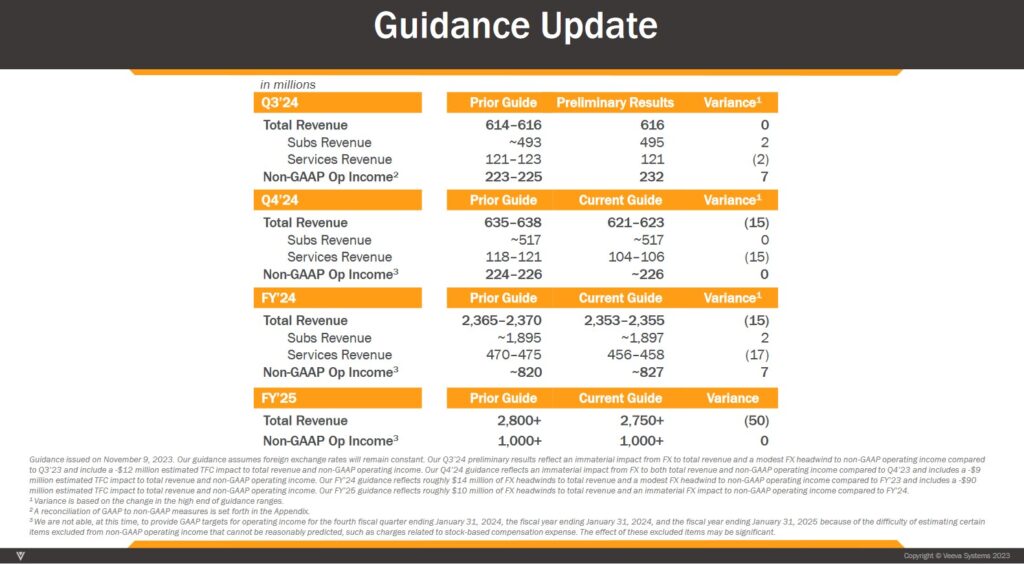
Source: VEEV - 2023 Investor Day Presentation - November 9, 2023
The following guidance provided with the December 6 release of Q3 and YTD2024 results reflects very minor adjustments.
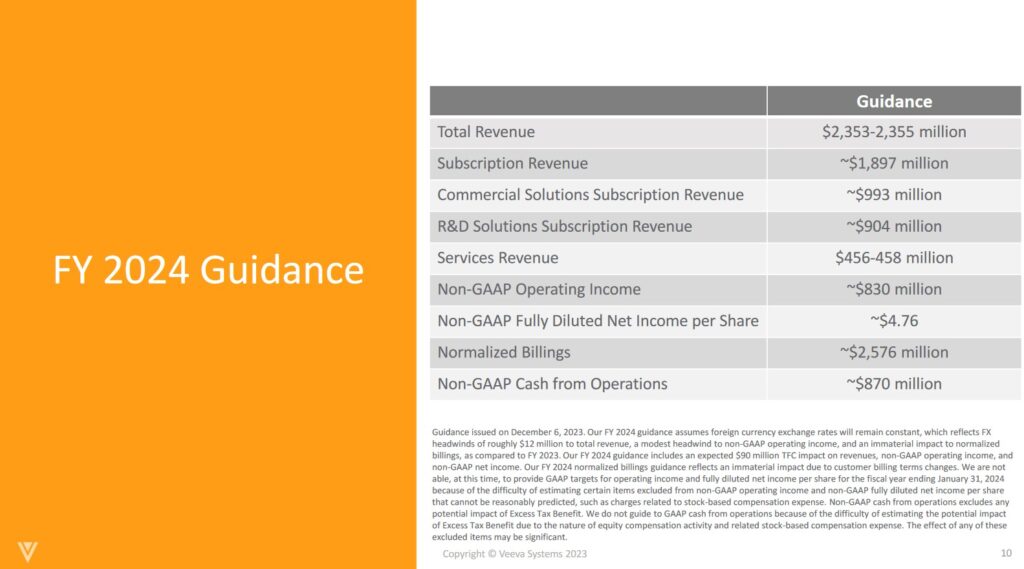
Source: VEEV - Q3 2024 Earnings Presentation - December 6, 2023
Risk Assessment
VEEV has no debt to rate.
At the end of Q3, VEEV had ~$0.744B in cash and cash equivalents and ~$3.2B in short-term investments.
Its total liabilities were ~$0.846B of which ~$0.644B was deferred revenue. This deferred revenue represents funds received from clients in advance in services being provided.
VEEV satisfies my risk averse investor profile.
Dividends and Dividend Yield
VEEV does not distribute a dividend.
The weighted average number of diluted shares outstanding (in millions rounded) in FY2021 - 2023 is 160.7, 162.2, and 162.4. In Q3 2024 it was 163.8.
VEEV ddoes not repurchase shares but rather issues shares annually as part of its employee compensation structure.
Valuation
VEEV's has historically been overvalued.
In FY2023, VEEV generated $4.28 in adjusted diluted EPS. Management's guidance for the current fiscal year is $4.76. With shares trading at $190, the forward adjusted diluted PE is ~40.
In the first 9 months of FY2024, VEEV generated $3.46 in adjusted diluted EPS versus $3.14 over the same timeframe in FY2023.
VEEV's valuation using the current broker estimates is:
- FY2024 - 26 brokers - mean of $4.79 and low/high of $4.74- $5.57. Using the mean estimate, the forward adjusted diluted PE is ~40.
- FY2025 - 25 brokers - mean of $5.57 and low/high of $5.26 - $6.10. Using the mean estimate, the forward adjusted diluted PE is ~34.
- FY2026 - 17 brokers - mean of $6.28 and low/high of $5.70 - $6.68. Using the mean estimate, the forward adjusted diluted PE is ~30.
Looking at VEEV's valuation based on FCF, I conservatively estimate FY2024 FCF will be ~$0.925B; at the end of 3 quarters it was ~$0.854B.
The weighted-average number of diluted shares in Q3 2024 was 163.761 million. FCF/share is, therefore, likely to be ~$5.21. Divide the current ~$190 share price by ~$5.21 and VEEV's forward P/FCF is ~36.5. This is somewhat better than the FY2024 forward adjusted diluted PE but still not sufficiently attractive for me to initiate a position.
Final Thoughts
VEEV's significant R&D investments has contributed toward its ability to capture a dominant position in cloud-service offerings for the life sciences industry.
It continues to develop new products and services and once it transitions from the Salesforce platform, it will have far greater control over its service offering.
I would initiate a position but my immediate concern is its current forward valuation.
It is highly unlikely that VEEV's forward adjusted diluted PE will drop into the 20s given its growth potential and strong financial performance. However, if VEEV's share price were to retrace to the mid $160s (it reached this level in early November) and there were no major changes to FY2024 guidance, the forward P/FCF would be closer to ~32.
This is a level at which I would consider initiating a position in the FFJ Portfolio. However, much would depend on other investment opportunities.
I wish you much success on your journey to financial freedom!
Note: Please send any feedback, corrections, or questions to [email protected].
Disclosure: I do not have exposure to VEEV and do not intend to initiate a position within the next 72 hours.
Disclaimer: I do not know your circumstances and do not provide individualized advice or recommendations. I encourage you to make investment decisions by conducting your own research and due diligence. Consult your financial advisor about your specific situation.
I wrote this article myself and it expresses my own opinions. I do not receive compensation for it and have no business relationship with any company mentioned in this article.


